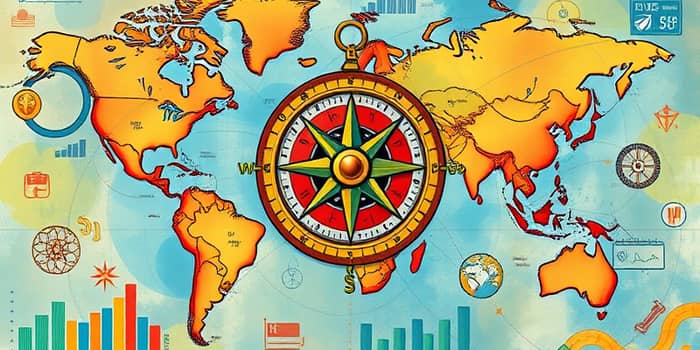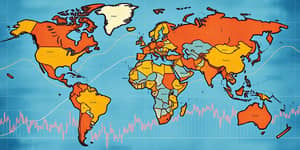In a rapidly shifting world economy, understanding the forces shaping growth, inflation, and trade is more critical than ever. As uncertainties multiply—from geopolitical tensions to fluctuating commodity prices—business leaders, policymakers, and citizens alike seek clarity. This comprehensive exploration decodes the complex data and trends for 2025–2026, offering both a panoramic view and practical guidance.
By examining forecasts from the IMF, OECD, and World Bank, we trace how slowing expansion, rising tariffs, and monetary policy shifts intersect. Armed with this knowledge, readers can anticipate challenges and seize opportunities in an era defined by policy unpredictability and dynamic global interdependence.
Global Growth and Inflation Trends
Major institutions present a mixed but cautionary picture for global GDP. The IMF forecasts world growth at 3.0% in 2025, edging to 3.1% in 2026—a modest upgrade driven by front-loaded activity, fiscal expansion, and improved financial conditions. Yet these projections remain 0.2 points below earlier forecasts due to persistent trade tensions.
Meanwhile, the OECD projects a slowdown to 2.9% in both 2025 and 2026, highlighting decelerations in the United States, Canada, Mexico, and China. The World Bank is starker, warning of just 2.3% growth in 2025—the weakest pace since 2008 outside of recessions. Inflationary pressures mirror these headwinds: the IMF sees global inflation at 4.2% next year, easing to 3.6% in 2026, while the OECD expects G20 inflation to moderate from 6.2% to 3.6% by 2025.
The Tariff Effect on Trade and Demand
Trade policy uncertainty stands out as a major drag on activity. World trade volumes stalled in early 2025, with container throughput falling below year-ago levels—particularly in Europe and China. New tariffs raise costs, squeeze profit margins, and undermine confidence across industries.
Key tariff changes in 2025 include:
- The United States imposing a 50% tariff on Brazilian imports.
- Canada hiking tariffs to 35% on non-free-trade goods.
- Mexico maintaining a 25% rate pending further negotiations.
These measures risk further contraction in trade flows, pushing inflation upward in some economies and suppressing demand in others. Companies must reassess supply chains and cultivate resilience against volatile policy shifts.
Monetary Policy and Financial Conditions
Central banks diverge sharply in their approaches. The European Central Bank is poised to ease further in 2025, while the Bank of Japan begins a cautious normalization into 2026. The U.S. Federal Reserve remains vigilant, delaying rate cuts amid persistent price pressures.
Emerging markets present a mixed picture: India, Mexico, and South Korea are easing to spur growth, whereas Brazil, Nigeria, and Turkey maintain tighter stances to defend currencies and contain inflation. Overall, financial conditions have improved somewhat due to a softer U.S. dollar, but gains are offset by supply-chain disruptions and commodity price headwinds.
Key Risks on the Horizon
Even modest deviations from baseline forecasts could trigger sharper downturns. Stakeholders must monitor these critical threats:
- Escalating trade barriers intensifying downward GDP revisions.
- Persistent regional conflicts and persistent regional conflicts disrupting markets.
- Volatile oil and metal prices reversing inflation gains.
- Extreme weather events threatening agricultural output and logistics.
- Policy missteps prolonging uncertainty and dampening investment.
Flexibility, diversified sourcing, and stress tests will be essential for businesses and governments seeking to weather these storms.
Regional Spotlights: Mapping Divergent Trajectories
Economic fortunes vary widely by region. The United States is expected to slow to 1.6% growth in 2025, cooling further to 1.5% in 2026. The Euro Area should see a modest rebound, rising from 1.0% to 1.2%. China’s expansion moderates to around 4.5% in 2025 and 4.0% in 2026, reflecting mixed signals on domestic demand and export performance.
Emerging markets like Brazil and Russia face contractions or persistent slowdown, underscoring the uneven nature of the recovery and the need for tailored policy responses.
Societal Impact and Outlook
Sluggish growth and rising costs challenge efforts to close income gaps and reduce poverty. Emerging economies now risk falling short of targets for extreme poverty reduction. Leading indicators paint a cautious picture: the U.S. LEI fell 2.7% in H1 2025, signaling economic weakening but not a full recession. Global LEIs also dipped, while muted consumer confidence weighs on retail spending and investment plans.
Despite these pressures, pockets of resilience remain. Technology sectors continue to innovate, service economies adapt to changing consumer habits, and green investments gain momentum in response to climate risks.
Navigating the Compass: Practical Strategies
For policymakers: maintain open dialogue on trade, pursue targeted fiscal support, and calibrate monetary policy with an eye on both inflation and growth. Businesses should diversify supply chains, invest in digital transformation, and hedge against commodity volatility. Individuals can build financial cushions, stay informed on economic shifts, and adapt skills to emerging industries.
By decoding the global economic compass—understanding forecasts, risks, and regional dynamics—stakeholders can transform uncertainty into strategic advantage. The horizon may be clouded, but a clear-eyed, resilient approach will guide us toward sustainable growth and shared prosperity.
References
- https://www.mckinsey.com/capabilities/strategy-and-corporate-finance/our-insights/global-economics-intelligence
- https://www.oecd.org/en/about/news/press-releases/2025/06/global-economic-outlook-shifts-as-trade-policy-uncertainty-weakens-growth.html
- https://www.spglobal.com/market-intelligence/en/news-insights/research/global-economic-outlook-july-2025
- https://www.ey.com/en_us/insights/strategy/global-economic-outlook
- https://www.conference-board.org/topics/us-leading-indicators/
- https://www.conference-board.org/topics/global-economic-outlook
- https://www.worldbank.org/en/publication/global-economic-prospects










